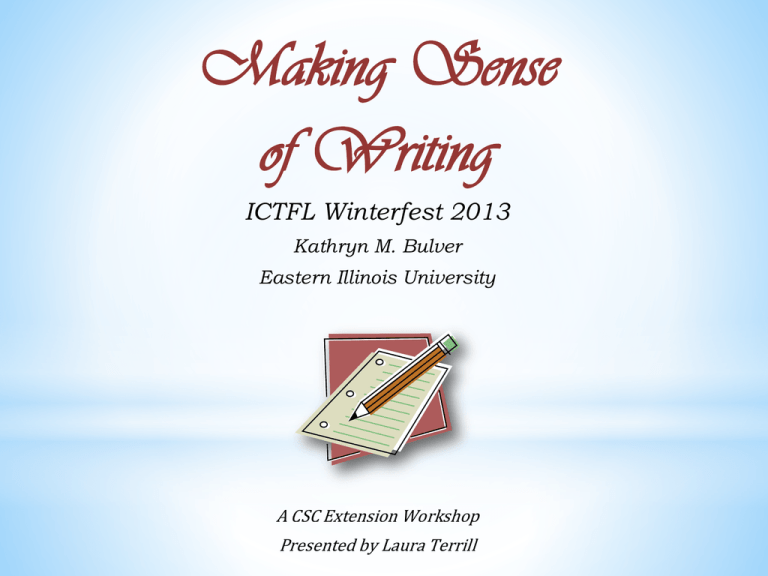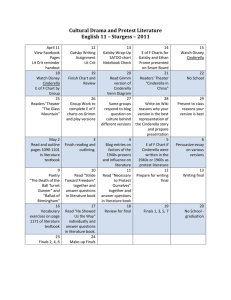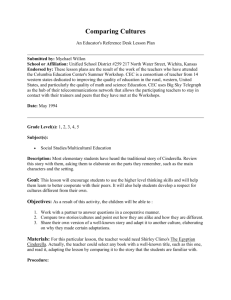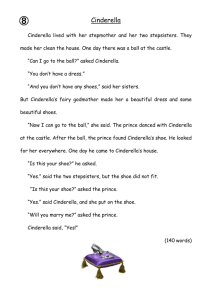Winterfest 2013 Part 1 - ICTFL WinterFest 2013
advertisement

Making Sense of Writing ICTFL Winterfest 2013 Kathryn M. Bulver Eastern Illinois University A CSC Extension Workshop Presented by Laura Terrill Making Sense of Writing Part 1 Laura Terrill lterrill@gmail.com lauraterrill.wikispaces.com Introductions Writing booklet « Writing » list 1 minute Expand on one word 2 minutes What steps? 1. Pre-writing (list that puts down ideas from the brain) 2. Individual writing (expand on idea) Read aloud (effective way to catch mistakes and check sentence fluency) Ask questions of reader, giving feedback to generate more ideas Why do we write? We write to: Express and reflect Inquire and Explore (writing to learn) Analyze and interpret Take a stand Evaluate and judge Propose a solution Seek common ground Inform or explain Report: research-based writing Reading Rhetorically: A Reader for Writers Bean, Chappell, and Gillam Why do we write? We write to: Express and reflect Inquire and Explore (writing to learn) Analyze and interpret Take a stand Evaluate and judge Propose a solution Seek common ground Inform or explain Report: research-based writing Take tests Reading Rhetorically: A Reader for Writers Bean, Chappell, and Gillam Percentage of 8th and 12th graders performing at or above a proficient level of writing achievement 2007 National Assessment of Educational Progress (NAEP) 1998 2002 2007 8th grade 28% 33% 35% 12th grade 23% 26% 25% Students write informative, persuasive and narrative texts for the writing assessment. Everyone has the capacity to write, writing can be taught, and teachers can help students become better writers. People learn to write by writing. - NCTE Beliefs about the teaching of writing November, 2004 ACTFL Integrated Performance Assessment Interpretive Communication Students listen to, view and / or read an authentic text and answer information as well as interpretive questions to assess comprehension. The teacher provides students with feedback on performance. Presentational Communication Students engage in the presentational mode by sharing their research/ideas/opinions. Sample presentational formats: speeches, drama, skits, videos, radio broadcasts, posters, brochures, essays, websites, etc. Interpersonal Communication After receiving feedback students engage in communication about a particular topic which relates to the interpretive text. Three Modes of Communication Interpretive Presentational Interpersonal What is the mode of communication? 1 Prepare a poster about your favorite sport. 2 Watch a travel video and jot down places of interest. 3 Talk about what to do on the weekend. 4 Send a letter to an e-pal. 5 Create a graphic organizer for new vocabulary. 6 Create a skit where you buy something in the market. What is the mode of communication? 1 Prepare a poster about your favorite sport. Presentational 2 Watch a travel video and jot down places of interest. Interpretive 3 Talk about what to do on the weekend. Interpersonal 4 Send a letter to an e-pal. Interpersonal 5 Create a graphic organizer for new vocabulary. Interpretive 6 Create a skit where you buy something in the market. Presentational French AP - 2012 Section 2 (Interpersonal and Presentational Communication), 50% of exam score — Free Response: 4 items Interpersonal Writing: You will write a reply to an e-mail message. You have 15 minutes to read the message and write your reply. Your reply should include a greeting and a closing and should respond to all the questions and requests in the message. In your reply, you should also ask for more details about something mentioned in the message. Also, you should use a formal form of address. French AP - 2012 Section 2 (Interpersonal and Presentational Communication), 50% of exam score — Free Response: 4 items Presentational Writing: You will write a persuasive essay to submit to a French writing contest. The essay topic is based on three accompanying sources that present different viewpoints on the topic and include both print and audio material. First, you will have 6 minutes to read the essay topic and the printed material. Afterward, you will hear the audio material twice; you should take notes while you listen. Then, you will have 40 minutes to prepare and write your essay. In your persuasive essay, you should present the sources’ different viewpoints on the topic and also clearly indicate your own viewpoint and defend it thoroughly. Use information from all of the sources to support your essay. As you refer to the sources, identify them appropriately. Also, organize your essay into clear paragraphs. ACTFL Keys to Proficiency Proficiency is evidenced by…. Comprehension/comprehensibility Language control Vocabulary Communication strategies Cultural competence ACTFL Proficiency Guidelines 2012 Novice Writers at the Novice level are characterized by the ability to produce lists and notes, primarily by writing words and phrases. They can provide limited formulaic information on simple forms and documents. These writers can reproduce practiced material to convey the most simple messages. In addition, they can transcribe familiar words or phrases, copy letters of the alphabet or syllables of a syllabary, or reproduce basic characters with some accuracy. Intermediate Writers at the Intermediate level are characterized by the ability to meet practical writing needs, such as simple messages and letters, requests for information, and notes. In addition, they can ask and respond to simple questions in writing. These writers can create with the language and communicate simple facts and ideas in a series of loosely connected sentences on topics of personal interest and social needs. They write primarily in present time. At this level, writers use basic vocabulary. Writers at the Advanced level are characterized by the ability to write routine informal and some formal correspondence, as well as narratives, descriptions, and summaries of a factual nature. They can narrate and describe in the major time frames of past, present, and future, using paraphrasing and elaboration to provide clarity. Advanced-level writers produce connected discourse of paragraph length and structure. At this level, writers show good control of the most frequently used structures and generic vocabulary, allowing them to be understood by those unaccustomed to the writing of non-natives. nd structures to express meaning that is comprehensible to those accustomed to the writing of non-natives. Novice Who are the people in this picture? Describe them. What do they like to do? What don’t they like to do? Intermediate-Low What did members of this family do yesterday? What questions would you like to ask about this family? Intermediate This family spends time together each week. What traditions exist in your family? Explain one tradition in detail. What are you currently doing to create or continue family traditions? What traditions will you establish when you have a family of your own? Describe a tradition that you hope will exist in your future. Advanced Many believe that families who have strong traditions have a better quality of life. Do you agree or disagree with this belief? What impact would stronger families have on our society? Support your opinions with specific examples. Cinderella Level I Cinderella is a girl. She isn’t happy. She works a lot. Her mother doesn’t like Cinderella. She has two sisters. They don’t like Cinderella. There is a ball. Cinderella doesn’t go to the ball.... Level II Cinderella is a poor young girl. She has two sisters who are not nice. And her mother doesn’t like her much. One day the family is going to go to the ball at the king’s castle. Cinderella can’t go because she doesn’t have a pretty dress.... Level III Once upon a time there was family of two sisters and their mother. They had a step-sister, Cinderella. The mother loved her two ugly and mean daughters, but she didn’t like Cinderella, who was beautiful and nice. One day, the king invited all the young girls to meet his son, the prince. But Cinderella, who didn’t have anything nice to wear, couldn’t go.... Level IV Once upon a time there was a family composed of a mother and her two mean and ugly daughters. In the small house lived Cinderella, the step-sister, who had to do all the household chores. Because of her great charm and beauty, Cinderella was hated by her step-mother and two step-sisters who were jealous. One day, there was an invitation sent by the king, who was giving a grand ball at the castle in honor of his son. All the young girls of the kingdom were invited; except Cinderella who, not having anything to wear for such a rich ball, could not attend.... Level V Once upon a time there was a girl named Cinderella whose stepmother made her work all day long. But her two vain and lazy step-sisters would only walk around in their beautiful dresses making fun of Cinderella who was always dressed for doing household chores. One day, a letter arrived from the king who was making preparations for a grand ball at which his son would choose his future bride from among all the young girls of the kingdom. Cinderella really wanted to attend but couldn’t because all she had were the old charwoman clothes she was wearing. 6 + 1 Traits of Writing Ruth Culham ISBN-13: 978-0439280389 Ideas Sentence Fluency Organization Word Choice Voice Conventions + Presentation “The 6+1 Trait® Writing Model of Instruction & Assessment provides a common language for teachers and students to communicate about the characteristics of writing and establishes a clear vision of what good writing looks like.” http://educationnorthwest.org/traits At the end of this workshop, you will: be able to define each of the 6+1 traits of writing be able to identify several activities for each trait understand the basics of 6+1 assessment have a base from which to pursue inquiry into the aspects of the 6+1 traits most useful to you Ideas Ideas make up the content of the piece. Writers move from the general to the specific. “They describe the bits and pieces of life, the ordinary, in extraordinary ways…They have something to say in their writing that no one else does. Their ideas come alive!” Ruth Culham Writing is Thinking Writing Makes Thinking Concrete Ideas Finding a Topic Focusing the Topic Developing the Topic Using Details INQUIRY who (subject) ? qui ? quién ? who...preposition ? préposition + qui ? preposición + quién ? what … préposition ? préposition + quoi ? preposición + qué ? what ? qu’est-ce qui ? qué ? who (object) ? qui est-ce que ? quién (object)? yes/no oui/non sí/no where ? où ? dónde ? why ? pourquoi ? por qué ? how ? comment ? cómo ? how many ?/how much ? combien (de) ? cuánto/a/os/as ? [since when ?*] depuis quand ? desde cuándo ? which ? quel(le)(s)____ ? qué ? when ? quand ? cuándo ? how long (time) ? depuis combien de temps ? desde cuánto tiempo ? what is/what are ? quel(le) est __ ? quel(le)s sont __ ? cuál es/cuáles son ? *English : can replace with idiomatic « How + adjective ? » Use Inquiry Inquiry is essential to good writing. images, art talking reading viewing Teammates Consult What are the implications of reaching 7 billion for the Earth’s population? Discuss with your group. Then, pick up a pen and write an answer in your own words. Writers consume more than they produce. Read like a writer. “Steal” characteristics of good text. Imitate familiar genres. Keep a writing log. Write about the writing itself. Copy interesting sentences and comment on what makes them effective. Consider how the author gets the reader’s attention. Think about how you might use a certain technique. Lists allow for both inquiry and drafting. Reasons not to lie Ways to spend $100 Things to do besides watch TV Things that make you smile Things you might find at the beach Lists Generate an “A – Z” listing on a specific topic. Freewrite on a specific word – beauty, dangerous, heroic, love, jealousy, etc. Create “big people” to explore characters. Use a “two voice” list to explore aspects of a topic. Create a “counting book” on a topic. Write a “how to” on a topic. Create an interview to share information on a topic Little Book of Questions & Answers My Home Contributing Writer: Teri Crawford Jones ABC Book – Each letter has been expanded ABC de Paris Raphaelle Aubert Counting Book I spy 8 boats. Vincent Van Gogh – Boats on the Beach I Spy Two Eyes: Numbers in Art Lucy Micklethwait Counting Book Next, two nets very useful for catching fish, crabs, and sea urchins. George’s Store at the Shore Francine Bassède Generating Ideas Student’s trace hand on paper. They write the important topic on the palm of the hand. They write 5 facts about the topic on each finger. Students pair with a partner to share their outline. Big People Trace a major character. Write notes about the character inside the body. Add specific events and page numbers outside body. Use as source for ideas. Deborah Dean Two Voice Poems http://www.writingfix.com/PDFs/Comparison_Contrast/Po em_Two_Voices.pdf Ask the Questions Write the Story who (subject) ? qui ? quién ? who...preposition ? préposition + qui ? preposición + quién ? what … préposition ? préposition + quoi ? preposición + qué ? what ? qu’est-ce qui ? qué ? who (object) ? qui est-ce que ? quién (object)? yes/no oui/non sí/no where ? où ? dónde ? why ? pourquoi ? por qué ? how ? comment ? cómo ? how many ?/how much ? combien (de) ? cuánto/a/os/as ? [since when ?*] depuis quand ? desde cuándo ? which ? quel(le)(s)____ ? qué ? when ? quand ? cuándo ? how long (time) ? depuis combien de temps ? desde cuánto tiempo ? what is/what are ? quel(le) est __ ? quel(le)s sont __ ? cuál es/cuáles son ? *English : can replace with idiomatic « How + adjective ? » Ask the Questions Write the Story Expand a Headline “Les Etats-Unis ont surmonté les démons du passé” (Le Monde) “La Chance de l’Amérique”…(Libération) Expand a Headline D’Obama à Zuckerberg, le monde pleure Steve Jobs (Le Nouvel Observateur) Develop ideas prompted by a visual (photo) or audio (sound effects or music) What I … saw heard felt (touched) smelled tasted felt (emotions) Variation: use with 5-6 similar images. Une carte postale arrive 72 ans plus tard Mardi 1 septembre, 06h16 Cette carte postale est arrivée à la poste de Monaco la semaine dernière, en provenance du centre de tri de Nice. Arrivée le 25 août 2009, la carte avait été postée le… 11 août 1937! Postée à Saint-Etienne-de-Tinée, dans les Alpes-Maritimes, par M. Achierdi, cette carte postale était destinée à Fernande, sa fiancée. Une fiancée décédé en 1969………… Expand an Outline Ask 3 to 5 questions to get more information about the following outline. 24 Heures à Paris got up, got dressed, breakfast at 8:00, museum at 10:00, lunch at noon, Eiffel Tower at 2:50, shopping at 4:00, portrait at 7:00, met someone special, dancing at 10:00, champagne at midnight, went home, fell asleep Developing ideas: « Framework » text vs. developed, fully « built » text with interesting detail that leaves the reader satisfied, without important questions unanswered. 1. Write your answer: what story is it? 2. Write your answer: what story is it? Expand to complete story. Picture This Use an image, show for 1 minute, cover, each student writes words, phrases and sentences to describe. Segment image into 6 quadrants, show each quadrant for 1 minute, allow students to write out-of-context description Finally show entire image again for one minute. 6 + 1 Traits of Wrting - Ruth Culham R.A.F.T.S. Role Audience Format Topic German government citizens of Guernica letter apology for what was done Franco people of Spain speech protestation of innocence Museum curator Picasso newspaper interview questions about the painting and likely answers Soldier Commander telegram reasons for defeat Mother Diary journal entry what happened and personal thoughts about war ? ? ? ? persuade, analyze, create, predict, compare, defend, evaluate… * I. Identify each component « Jean de Florette » Example: Role = Ugolin Audience = Jean Cadoret/Jean de Florette Format = letter Topic = why Jean and his family should return to the city Strong verb = convince II. Write the prompt in paragraph form (“you are…”/”vous êtes..”/”Ud. es…”) R F A S You are Ugolin. Write a letter to Jean Cadoret to convince him and his family to T sell you his farm and return to the city. * 3-6 characters/groups(from novel, short story, movie…) * draw 1 character/page, with 4-5 descriptive adjectives or phrases, and an object that represents the character (alternative: 1 character over two facing two pages: image and description) * pair or small-group share * follow-up writing * * 3-6 objects, with importance and links to or between characters * 3-6 scenes from story, with key image to summarize them *


